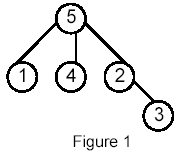[NWPU][2014][TRN][22]RMQ和LCA E - LCA POJ 1470
2014-09-06 21:13
302 查看
E - LCA
Time Limit:2000MS Memory Limit:10000KB 64bit IO Format:%I64d
& %I64u
Submit Status Practice POJ
1470
Description
Write a program that takes as input a rooted tree and a list of pairs of vertices. For each pair (u,v) the program determines the closest common ancestor of u and v in the tree. The closest common ancestor of two nodes u and v is the node w that is an ancestor
of both u and v and has the greatest depth in the tree. A node can be its own ancestor (for example in Figure 1 the ancestors of node 2 are 2 and 5)
Input
The data set, which is read from a the std input, starts with the tree description, in the form:
nr_of_vertices
vertex:(nr_of_successors) successor1 successor2 ... successorn
...
where vertices are represented as integers from 1 to n ( n <= 900 ). The tree description is followed by a list of pairs of vertices, in the form:
nr_of_pairs
(u v) (x y) ...
The input file contents several data sets (at least one).
Note that white-spaces (tabs, spaces and line breaks) can be used freely in the input.
Output
For each common ancestor the program prints the ancestor and the number of pair for which it is an ancestor. The results are printed on the standard output on separate lines, in to the ascending order of the vertices, in the format: ancestor:times
For example, for the following tree:

Sample Input
Sample Output
Hint
Huge input, scanf is recommended.
Time Limit:2000MS Memory Limit:10000KB 64bit IO Format:%I64d
& %I64u
Submit Status Practice POJ
1470
Description
Write a program that takes as input a rooted tree and a list of pairs of vertices. For each pair (u,v) the program determines the closest common ancestor of u and v in the tree. The closest common ancestor of two nodes u and v is the node w that is an ancestor
of both u and v and has the greatest depth in the tree. A node can be its own ancestor (for example in Figure 1 the ancestors of node 2 are 2 and 5)
Input
The data set, which is read from a the std input, starts with the tree description, in the form:
nr_of_vertices
vertex:(nr_of_successors) successor1 successor2 ... successorn
...
where vertices are represented as integers from 1 to n ( n <= 900 ). The tree description is followed by a list of pairs of vertices, in the form:
nr_of_pairs
(u v) (x y) ...
The input file contents several data sets (at least one).
Note that white-spaces (tabs, spaces and line breaks) can be used freely in the input.
Output
For each common ancestor the program prints the ancestor and the number of pair for which it is an ancestor. The results are printed on the standard output on separate lines, in to the ascending order of the vertices, in the format: ancestor:times
For example, for the following tree:

Sample Input
5 5:(3) 1 4 2 1:(0) 4:(0) 2:(1) 3 3:(0) 6 (1 5) (1 4) (4 2) (2 3) (1 3) (4 3)
Sample Output
2:1 5:5
Hint
Huge input, scanf is recommended.
//@auther Yang Zongjun
#include <iostream>
#include <cstdio>
#include <vector>
#include <string.h>
//#include <string>
#include <cstring>
using namespace std;
#define PI acos(-1.0)
#define EPS 1e-8
const int N = 1005;
const int INF = 2100000000;
vector<int> edge
;
int query
,father
,count
,indeg
;
int vis
,n,m;
int findSet(int x){
if(x!=father[x]){
father[x]=findSet(father[x]);
}
return father[x];
}
void Tarjan(int u){
father[u]=u;
for(int i=0;i<edge[u].size();i++){
Tarjan(edge[u][i]);
father[edge[u][i]]=u;
}
vis[u]=1;
for(int i=1;i<=n;i++)
if(vis[i] && query[u][i])
count[findSet(i)]+=query[u][i];
}
int main()
{
//freopen("C:/Users/Admin/Desktop/input.txt", "r", stdin);
//while(cin >> n)
while(scanf("%d", &n) != EOF)
{
//cin >> n;
//while(n--)
//{
for(int i = 1; i <= n; i++)
{
edge[i].clear();
}
memset(query, 0, sizeof(query));
memset(vis, 0, sizeof(vis));
memset(count, 0, sizeof(count));
memset(indeg, 0, sizeof(indeg));
int u, v, num; char c;
int t = n;
while(t--)
//for(int j = 0; j < n; j++)
{
//cin >> u >> c >> c >> num >> c;
scanf("%d:(%d)", &u, &num);
//cout << u << " " << num << u + num << endl;
while(num--)
{
//cin >> v;//cout << v << endl;
scanf(" %d", &v);
edge[u].push_back(v);
indeg[v]++;
}
}
//}
scanf("%d", &m);
//int u, v; char c;
while(m--)
{
scanf(" (%d %d)", &u, &v);
//cin >> c >> u >> v >> c;
//cout << u << v << endl;
query[u][v]++;
query[v][u]++;
}
for(int i = 1; i <= n; i++)
{
if(indeg[i] == 0)
{
Tarjan(i);break;
}
}
for(int i = 1; i <= n; i++)
{
if(count[i])
{
//cout << i << ":" << count[i] << endl;
printf("%d:%d\n", i, count[i]);
}
}
}
return 0;
}
相关文章推荐
- [NWPU][2014][TRN][22]RMQ和LCA C - RMQ POJ 3264
- [NWPU][2014][TRN][13]线段树第一讲 A - 基础 POJ 2352
- [NWPU][2014][TRN][5]二分和贪心 M - 贪心 基础 POJ 2709
- [NWPU][2014][TRN][13]线段树第一讲 B - 基础 POJ 3264
- 7-12 [NWPU][2014][TRN][3]搜索 D - 广搜 基础 POJ 1915
- 7.12 [NWPU][2014][TRN][3]搜索 POJ 1562 H - 深搜/广搜 基础
- POJ 1470 Closest Common Ancestors (在线LCA转RMQ)
- [NWPU][2014][TRN][17]最小生成树 B - 基础 POJ 2421
- LCA三种算法学习(离线算法tarjan+在线算法转rmq+在线倍增)例题poj1330、1470;hdu4547、2874
- [NWPU][2014][TRN][18]最短路问题 A - 模板 POJ 2387
- [NWPU][2014][TRN][21]数论入门 B - 扩展欧几里得 POJ 1061
- [NWPU][2014][TRN][12]并查集D - A Bug's Life POJ 2492
- POJ 1470 Closest Common Ancestors(LCA&RMQ)
- POJ 1470 Closest Common Ancestors [LCA+RMQ]
- POJ 1986 Distance Queries 【RMQ LCA】双向存边
- POJ 1330 Nearest Common Ancestors【LCA_(rmq 在线 + tarjan 离线)】
- POJ 1470 LCA问题,一次AC的,很鸡冻!
- POJ 1330 Nearest Common Ancestors (在线LCA转RMQ)
- [NWPU][2014][TRN][3]搜索 总结
- POJ1470/ZOJ1141 Closest Common Ancestors(LCA离线算法)
